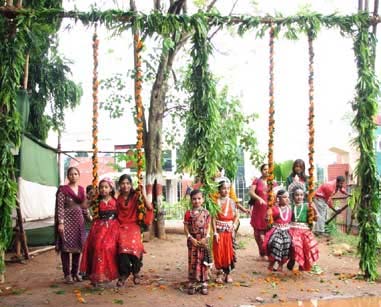Bhubaneswar: Odisha is abuzz with the vibrant spirit of the Raja festival, a unique three-day celebration that beautifully intertwines themes of womanhood, fertility, and the profound reverence for Mother Earth. As the festivities commence today, June 14, 2025, the air is filled with joyous anticipation and cultural pride, a sentiment echoed in the greetings extended by the President, Governor, and Chief Minister.
At its core, Raja Parba, also known as Mithuna Sankranti, is a symbolic observance of Mother Earth’s own menstrual cycle. Just as women undergo this natural process as a sign of their fertility and ability to create life, so too is the Earth believed to “menstruate” during this period, preparing herself for renewed agricultural vigor with the onset of the monsoon season. This deep-rooted belief highlights the profound connection between women and nature in Odia culture.
The festival unfolds in a series of culturally significant phases. The first day, known as Pahili Raja, serves as a prelude where homes are cleaned, and preparations are made. The most auspicious day, Raja Sankranti, marks the beginning of the solar month of Asadha and the official start of the monsoon. The third day, Basi Raja (or Bhudaaha), continues the festive spirit, leading to the concluding ritual of Basumati Snana on the fourth day, where a grinding stone, symbolizing Mother Earth (Bhumi), is ritually bathed with turmeric paste and adorned with flowers.
During Raja, a distinctive set of traditions comes alive. Women, especially unmarried girls, are at the heart of the celebration. They are traditionally relieved from household chores, allowing them to rest and revel in their femininity. Adorned in new clothes, with hands embellished with henna and feet painted with crimson alta, they gather to enjoy the simple pleasures of life. Swings, known as ‘Raja Doli,’ are a central feature, hung from mango and banyan trees, where girls playfully sway while singing traditional folk songs that speak of love, social harmony, and the beauty of nature.
Culinary delights also play a significant role, with homes brimming with the aroma of special ‘Pithas’ (traditional cakes). ‘Poda Pitha,’ a slow-cooked sweet cake made from rice, coconut, and jaggery, is a particular favorite. Other delicacies like Arisha, Kakara, and Chakuli Pitha are also prepared and shared, fostering a strong sense of community bonding. The festival is considered incomplete without the enjoyment of ‘Raja Pana,’ a sweet betel leaf preparation.
Beyond the vibrant customs and delicious food, Raja carries a powerful cultural message. It normalizes menstruation, traditionally a taboo subject in many societies, by celebrating it as a sacred and vital aspect of creation and fertility. It emphasizes the importance of respecting nature’s cycles and living in harmony with the environment. The pausing of agricultural activities during these days is a direct reflection of this reverence for the Earth’s restorative period.
As President Droupadi Murmu, Governor Hari Babu Kambhampati, and Chief Minister Mohan Charan Majhi extended their heartfelt greetings, they underscored the enduring significance of Raja Parba as a festival that celebrates womanhood, honors the land, and reinforces the rich cultural heritage of Odisha. Their messages highlighted the festival’s ability to inspire harmony with nature and bring joy and prosperity to all. Raja Parba, truly a unique confluence of tradition, agriculture, and profound respect for the feminine, continues to thrive as a beacon of Odia identity.


